KSEEB Solutions for Class 8 Science Chapter 14 Chemical Effects of Electric Current Point To Remember
Materials through which electric current can pass easily are called conductors of electricity. Electrical conductivity is a measure of the ability of a substance to allow the flow of an electric current.
Among solids, metals and graphite are good conductors of electricity and have high electrical conductivity. Some liquids are also good conductors. Pure water or distilled water is a poor conductor of electricity. But the presence of even a small amount of impurities(salts and minerals) makes water a good conductor as it contains ions through which conduction takes place.
Hence water from taps, wells, ponds, rivers, seas, lakes, etc. conducts electricity as they contain impurities. Most liquids that conduct electricity are solutions of acids, bases, and salts. When electricity is passed through a conducting solution, the molecules of the solution dissociate into ions. Ions are atoms or groups of atoms with a positive or negative charge.
These ions cause electrical conduction through the liquid. A liquid that conducts electricity due to the presence of ions is called an electrolyte.
Electrolysis:
1. The process of decomposition of a chemical compound in a solution when an electric current passes through it is called electrolysis. This process is due to the chemical effect of electric current.
2. Two electrodes are inserted in the solution and are connected to the terminals of a battery with a switch in between. This arrangement is called an electrolytic cell.
3. The electrode that is connected to the positive terminal of the battery is called the anode, and the other connected to the negative terminal is called the cathode.
4. Electrolysis is used in refining and extraction of metals from impure samples. This process is called electrorefining. It is also useful in coating one metal with another This process is called electroplating.
5. The passage of an electric current through a conducting solution causes chemical reactions. This is known as the chemical effect of electric current.
Some of the chemical effects of electric current are the following:
1. Formation of bubble of gas on the electrodes
2. Deposition of metal on electrodes
3. Change in colour of solutions
Electroplating:
1. The process of depositing a layer of any desired metal on another material by means of electricity is called electroplating.
2. The object to be electroplated is made the cathode (negative electrode) by connecting it to the negative terminal of the battery.
3. The metal which has to be deposited is made the anode (positive electrode) by connecting it to the positive terminal of the battery. The electrolyte is usually a salt solution of the metal to be coated.
Application of Electroplating:
1. Metals that rust are often coated with other metals to prevent rusting.
2. Chromium plating is found on bath taps car bumpers, etc. to give a bright attractive appearance and resist scratches and wear.
3. Silver plating is done on cutlery and jewellery items.
4. Tin cans, used for storing food, are made by electroplating tin onto the iron. Tin is less reactive than iron. Thus, food does not come into contact with iron and is protected from getting spoilt.
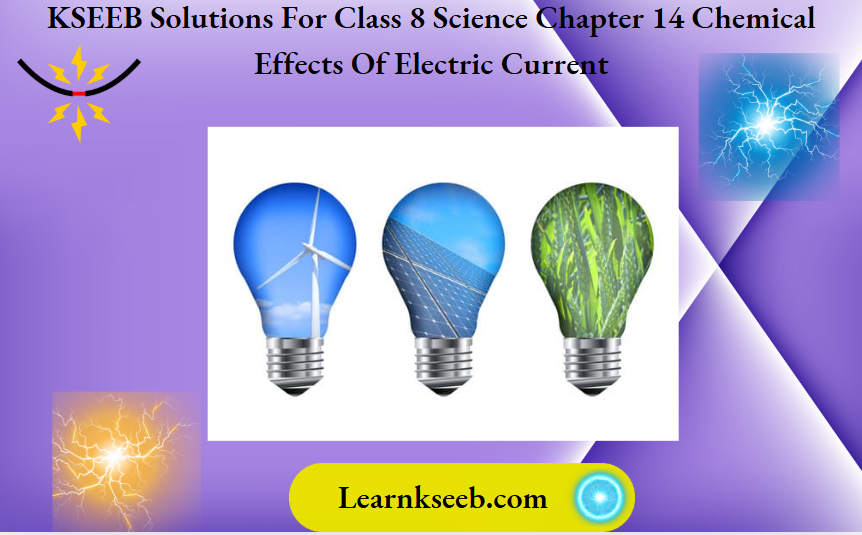
Kseeb Solutions For Class 8 Science Chapter 14 Chemical Effects Of Electric Current Pdf
Chemical Effects Of Electric Current NCERT Text Book Exercises
Question 1. Fill in the blanks.
1. Most liquids that conduct electricity are solutions of _____,_____and ____.
2. The passage of an electric current through a solution causes effects.
3. If you pass current through copper sulphate solution, copper gets deposited on the plate connected to the _____ terminal of the battery.
4. The process of depositing a layer of any desired metal on another material by means of electricity is called _____
Answer:
1. Most liquids that conduct electricity are solutions of acids, bases and salts.
2. The passage of an electric current through a solution causes chemical effects.
3. If you pass current through copper sulphate solution, copper gets deposited on the plate connected to the negative terminal of the battery.
4. The process of depositing a layer of any desired metal on another material by means of electricity is called electroplating.
Question 2. When the free ends of a tester are dipped into a solution, the magnetic needle shows deflection. Can you explain the reason?
Answer: Yes, it is because the solution conducts electricity and the solution plays the role of the cell.
Question 3. Name three liquids, when tested in a manner that may cause the magnetic needle to deflect.
Answer: It may be the salt solution in water.
Question 4. The bulb does not glow in the setup List the possible reasons. Explain your answer?
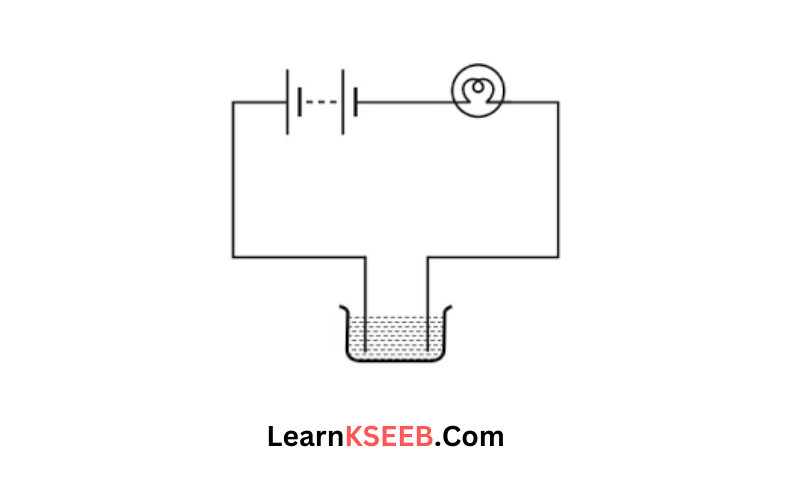
Karnataka Board Class 8 Science Chapter 14 Solutions
Answer: The possible reasons are:
1. The solution may be conducting electricity but the current produced is too small so that the filament of the bulb does not get heated and the bulb does not glow.
2. It is possible that the connections are loose.
3. The cells are used up.
Question 5. A tester is used to check the conduction of electricity through two liquids. labelled A and B. it is found that the bulb of the tester glows brightly for liquid A while it glows very dimly for liquid B. you would conclude that
1. Liquid A is a better conductor than liquid B
2. Liquid B is a better conductor than liquid A
3. Both liquids are equally conducting
4. Conducting properties of liquid cannot be compared in this manner.
Answer:
1. Liquid A is a better conductor than liquid B.
Question 6. Does pure water conduct electricity? If not, what can we do to make it conduct?
Answer: No. Pure water does not conduct electricity. This is because pure water is devoid of any salts. Pure water can conduct electricity when a pinch of common salt is added to it as the salt solution is conducting in nature.
Question 7. In case of fire, before the firemen use the water hoses, they shut off the main electric supply for the area. Explain why they do this.
Answer: Water may conduct electricity. If the electrical supply for the area is not shut off and water is poured over electrical appliances, then electricity may pass through the water and harm the firemen. That is why, in case of a fire, the firemen shut off the main electrical supply for the area before they use the water hoses.
Question 8. A child staying in a coastal region tests the drinking water and also seawater with his tester. He finds that the compass needle deflects more in the case of seawater. Can you explain the reason?
Answer: Impure water is the conductor of electricity. Sea water contains more impurities than drinking water found in the coastal region. Therefore, seawater conducts more electricity than drinking water. That is why the compass needle deflects more in the case of seawater.
Question 9. Is it safe for the electrician to carry out electrical repairs outdoors during heavy rain pour? Explain.
Answer: When it rains heavily, the rainwater dissolves many impurities from the atmosphere, which make it impure and very conductive of electricity. The air becomes humid with this water and becomes very conductive. That is why, it is not wise for an electrician to do electrical repair work when it rains heavily, because he may get dreadful shock or even gets an electric shock.
Chemical Effects Of Electric Current Class 8 Kseeb Solutions With Answers
Question 10. Paheli had heard that rainwater is as good as distilled water. So, she collected some rainwater in a clean glass tumbler and tested it using a tester. To her surprise, she found that the compass needle showed deflection. What could be the reason?
Answer: Rainwater is, of course, as good as distilled water but, when it passes through the atmosphere It dissolves a lot of dust dirt and impurities and becomes conducting. So, when Paheli used a tester, its compass showed deflection.
Question 11. Prepare a list of objects around you that are electroplated.
Answer: The objects which are electroplated are:
1. Taps of water connection.
2. Parts of the bicycle.
3. Body of cars, motorcycles and tractors.
4. Handles of the doors.
Question 12. The process is used for the purification of copper. A thin plate of pure copper and a thick rod of impure copper are used as electrodes. Copper from impure rod is sought to be transferred to the thin copper plate. Which electrode should be attached to the positive terminal of the battery and why?
Answer: The thick rod of impure copper should be attached to the positive terminal of the battery. This is because the free copper of the solution will get deposited on the thin rod and the loss of copper from the solution will be restored from the thick rod to the positive terminal of the battery. Thus, copper from the thick rod could be extracted.
Kseeb Class 8 Science Chemical Effects Of Electric Current Exercise Solutions
Chemical Effects Of Electric Current Activities
Question 1. Join the free ends of the tester together for a moment. This completes the circuit of the tester and the bulb should glow. However, if the bulb does not glow, it means that the tester is not working. Can you think of the possible reasons? Is it possible that the connections are loose? Or, the bulb is fused? Or, your cells are used up? Check that all the connections are tight. If they are, then replace the bulb with another bulb. Now test if the tester is working or not. If it is still not working then replace the cells with fresh cells.
Answer: In this activity, if the bulb does not glow, it means that either the connections of the circuit are loose or the bulb is fused or cells are used up. If the tester is working, it can be used to test the materials, i.e., whether it is a conductor or non-conductor of electricity.
Question 2. Collect a few small plastics or rubber caps of discarded bottles and clean them. Pour one teaspoon of lemon juice or vinegar into one cap. Bring your tester over this cap and let the ends of the tester dip into lemon juice or vinegar Take care that the ends are not more than 1 cm apart but at the same time do not touch each other. Does the bulb of the tester glow? Does lemon juice or vinegar conduct electricity? How would you classify lemon juice or vinegar—a good conductor or a poor conductor?
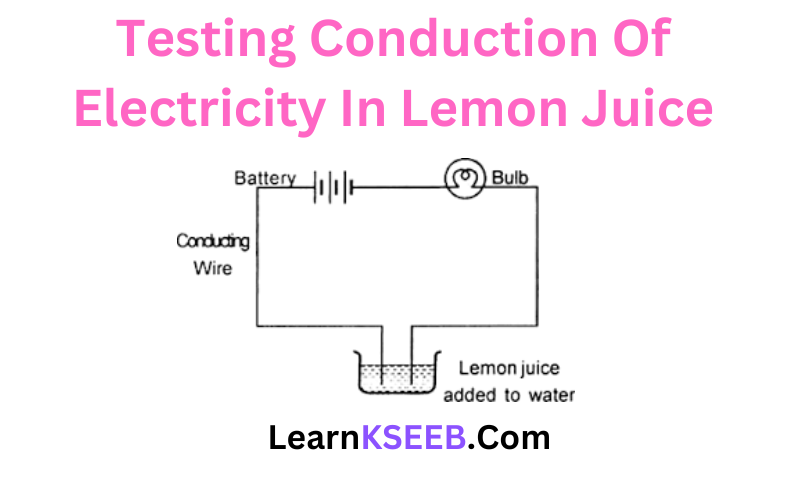
Answer: In this activity the bulb glows which shows that lemon juice and vinegar both conduct electricity, hence they are good conductors of electricity.
Question 3. Take the tray from inside a discarded matchbox. Wrap an electric wire a few times around the tray. Place a small compass needle inside it. Now connect one free end of the wire to the terminal of a battery. Leave the other end free. Take another piece of wire and connect it to the other terminal of the battery Join the free ends of two wires momentarily. The compass needle should show deflection. Your tester with two free ends of the wire is ready. Now repeat using this tester. Do you find a deflection in the compass needle the moment you dip the free ends of the tester in lemon juice?
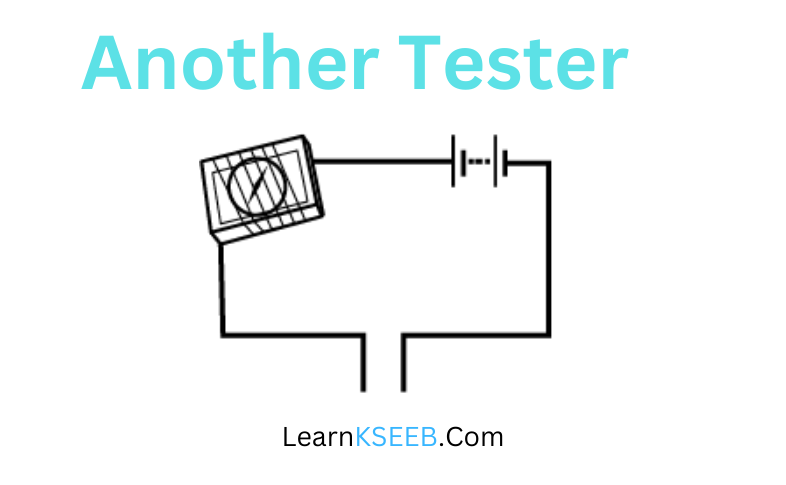
Answer: Take out the ends of the tester from the lemon Juice, dip them in water and then wipe them dry. Repeat the activity with other liquids such as tap water, vegetable oil, milk, and honey. (Remember to wash and wipe the ends of the tester after testing each liquid). In each case observe whether the magnetic needle shows deflection or not.
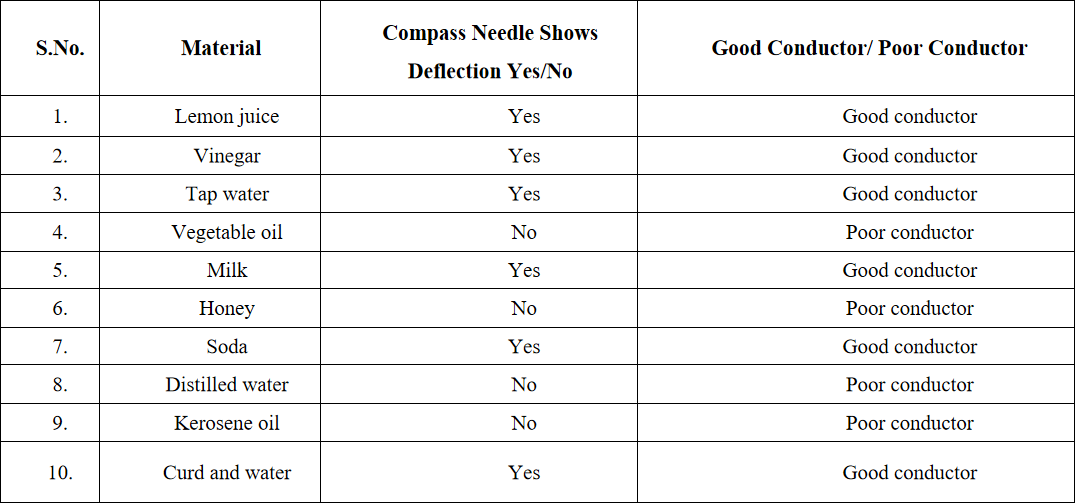
Thus, lemon juice, vinegar, tap water, milk, curd and water, and soda are good conductors of electricity while vegetable oil, honey, kerosene oil, and distilled water are poor conductors of electricity or insulators.
Karnataka Board 8th Science Chapter 14 Important Questions And Answers
Question 4. Take about two teaspoonfuls of distilled water in a clean and dry plastic or rubber cap of a bottle. (You may obtain distilled water from your school science lab. You may also get distilled water from a medical store or a doctor or a nurse). Use the tester to test whether distilled water conducts electricity or not. What do you find? Does distilled water conduct electricity? Now dissolve a pinch of common salt in distilled water. Again test. What do you conclude this time?
Answer: If the tester is put in distilled water, the bulb of the tester does not glow. This shows that distilled water does not conduct electricity. But when salt is dissolved in distilled water and again tested, the bulb glows which shows that water containing salts conducts electricity. Thus water which is free of salts is poor conductor while water with salts is a good conductor of electricity.
Question 5. Take three clean plastic or rubber caps of bottles. Pour about two teaspoonfuls of distilled water into each of them. Add a few drops of lemon juice or dilute hydrochloric acid to distilled water in one cap. Now in the second cap containing distilled water, add a few drops of a base such as caustic soda or potassium iodide. Add a little sugar to the distilled water in the third cap and dissolve it. Test which solutions conduct electricity and which do not. What results do you obtain?
Answer: First and second cap with acid and base respectively, conducts electricity whereas the third cap having sugar dissolved in distilled water does not conduct electricity.
Question 6. Take out carbon rods carefully from two discarded cells. Clean their metal caps with sandpaper. Wrap copper wires around the metal caps of the carbon rods and join them to a battery. We call these two-rod electrodes. (Instead of carbon rods, you may take two iron nails about 6 cm long.) Pour a cupful of water into a glass/ plastic bowl. Add a teaspoonful of salt or a few drops of lemon juice to water to make it more conducting. Now immerse the electrodes in this solution. Make sure that the metal caps of the carbon rods are outside the water. Wait for 3-4 minutes. Observe the electrodes carefully. Do you notice any gas bubbles near the electrodes? Can we call the change taking place in the solution a chemical change?
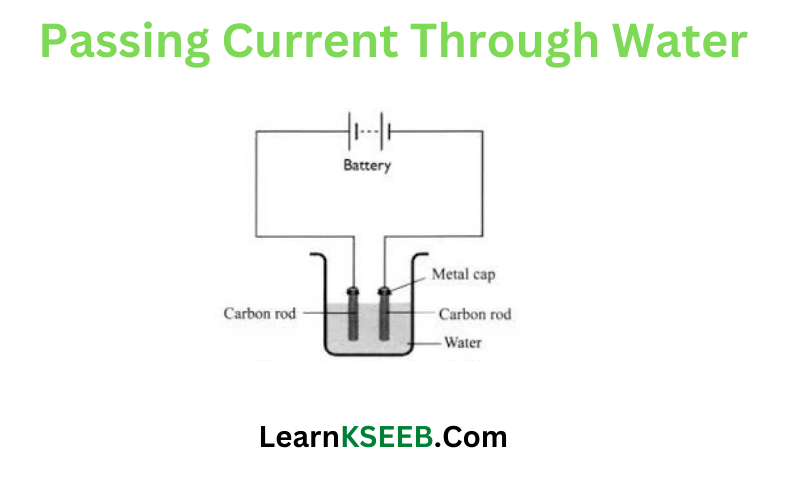
Answer: On passing an electric current through the conducting solution of lemon juice and water, a chemical reaction takes place. Water is dissociated into its constituent gases, ie., hydrogen and oxygen. Oxygen bubbles are formed on the electrode connected to the positive terminal of the battery and hydrogen bubbles are formed on the other electrode. Changes in the colour of solutions may occur depending on what solution and electrodes are used. This process is known as the chemical effects of current.
Chemical Effects Of Electric Current Class 8 KSEEB Questions And Answers
Question 7. We will need copper sulphate and two copper plates of size around 10 cm x 4 cm. Take 250 ml. of distilled water in a clean and dry beaker. Dissolve two teaspoonfuls of copper sulphate in it. Add a few drops of dilute sulphuric acid to the copper sulphate solution to make it more conducting. Clean copper plates with sandpaper. Now rinse them with water and dry them. Connect the copper plates to the terminals of a battery and immerse them in copper sulphate solution.
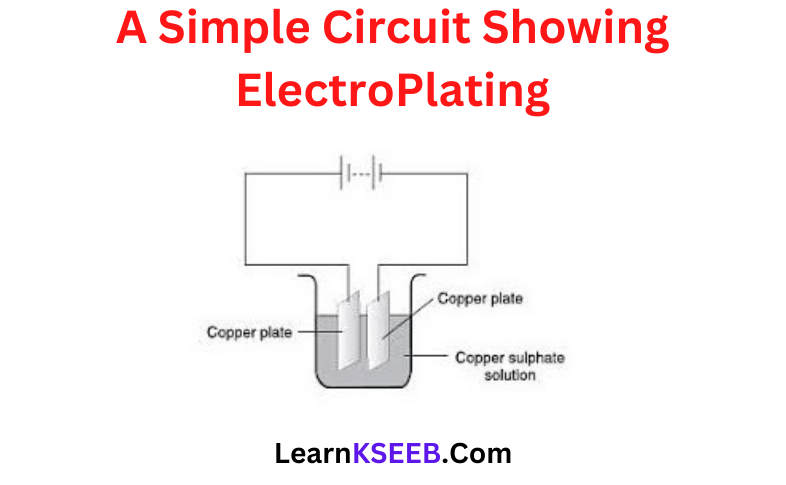
Allow the current to pass for about 15 minutes. Now remove the electrodes from the solution and look at them carefully. Do you find any difference in any one of them? Do you find a coating over it? What colour is the coating? Note down the terminal of the battery with which this electrode is connected.
Answer: After removing the electrodes from the solution, we find that copper metal gets deposited on the plate at the negative of the battery. It is concluded that when an electric current is passed through the copper sulphate solution, copper sulphate dissociates into copper and sulphate. The free copper gets deposited on the plate acting as a cathode. Gradually, a layer of copper builds up on the plate. This process is known as electroplating.
Chemical Effects Of Electric Current Additional Questions
Question 1. What are good conductors?
Answer: The substances that conduct electricity through them are called good conductors.
Question 2. Give four examples of insulators.
Answer: Air, wood, rubber and plastic.
Question 3. Name two metal objects which have a coating of another metal.
Answer: Handlebars of bicycles, bathroom taps.
Question 4. Is air a bad or good conductor?
Answer: A bad conductor.
Question 5. Which metal is plated on handlebars of cycles and the rim of wheels?
Answer: Chromium
Question 6. What is the full form of LED?
Answer: Light Emitting Diode.
Question 7. Which part of an atom is responsible for the flow of current?
Answer: Electron
Kseeb Class 8 Science Chapter 14 Textbook Solutions
Question 8. Why do most liquids conduct electricity?
Answer: Due to the presence of ions in them, most liquids conduct electricity,
Question 9. An LED is a more efficient device than a bulb. Why?
Answer: LED is more efficient because it can glow even when a weak or lost current flows through it.
Question 10. Do lemon juice or vinegar conduct electricity?
Answer: Yes, they conduct electricity.
Question 11. How is the conductivity of liquids tested?
Answer: By using a tester.
Question 12. Why is tin electroplated on iron to make cans used for storing food?
Answer: Tin is less reactive than iron. The tin coating prevents food from coming in contact with iron and thus prevents it from getting spoiled or corroded.
Question 13. What effect of current does electroplating show?
Answer: Chemical effect
Question 14. Which effect of current causes the bulb to glow?
Answer: Heating effect
Question 15. Name the three effects of electric current.
Answer: Heating, magnetic and chemical effects.
Question 16. How can the magnetic effect of current be checked?
Answer: By using a magnetic compass.
Question 17. What is electroplating?
Answer: The deposition of a thin layer of metal over another metal by electrolysis is called electroplating.
Question 18. What happens when an electric current is passed through the copper sulphate solution?
Answer: When an electric current is passed through the copper sulphate solution, copper sulphate dissociates into copper and sulphate. The free copper gets drawn to the electrode connected to the negative terminal of the battery and gets deposited on it.
Explanation Of Chemical Effects Of Electric Current In KSEEB Science
Question 19. On what factors thickness of the electroplated items depend?
Answer:
1. Thickness of electroplated items depends upon:
2. The strength of the current passing through the circuit.
3. The concentration of the metal in the solution.
4. The duration of the time the article has been in the solution.
Question 20. With the help of a suitable diagram, explain the electrolytic refining of copper.
Answer: To purify copper, a thin plate of pure copper and a thick rod of impure copper are used as electrodes in the acidified solution of CuSO4. Pure copper is used as a cathode and impure copper is used as the anode. When an electric current is passed through the copper sulphate solution, copper sulphate dissociates into copper and sulphate. The free copper gets drawn to the electrode connected to the negative terminal of the battery and gets deposited on it. From the impure copper electrode, an equal amount of copper gets dissolved in the solution. Thus, the loss of copper from the solution is restored and the process continues. The impurities are left behind at the anode.
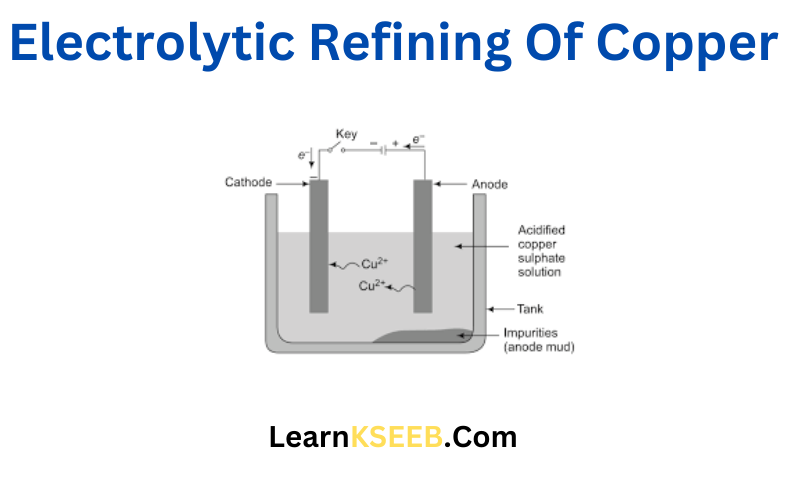
Chemical Effects Of Electric Current Multiple Choice Questions
Question 1. An electric current can produce
1. Heating effect only.
2. Chemical effect only.
3. Magnetic effect only.
4. Chemical, heating, and magnetic effects.
Answer: 4. Chemical, heating, and magnetic effects.
Explanation:
1. Electric current causes a chemical reaction when it passes through a conducting solution. This is a chemical effect of electric current.
2. When an electric current passes through the bulb. Its filament gets heated and the bulb starts glowing. This is the heating effect of electric current.
3. When an electric current is passed through a circuit it produces a magnetic field around it. This is the magnetic effect of electric current.
Question 2. Boojho and Paheli performed experiments taking similar bulbs and cells but two different solutions

They found that the bulb glows more brightly as compared to that You would conclude that
1. Higher current is flowing through the circuit
2. Higher current is flowing through the circuit
3. Equal current is flowing through both circuits.
4. The current flowing through the circuits in the two setups cannot be compared in this manner.
Answer: 1. Higher current is flowing through the circuit
Explanation: Higher current is flowing through the circuit
Kseeb 8th Standard Science Chapter 14 Notes And Solutions
Question 3. Boojho’s uncle has set up an electroplating factory near his village. He should dispose of the waste from the factory
1. In the nearby river.
2. In the nearby pond.
3. In the nearby cornfield.
4. According to the disposal guidelines of the local authority.
Answer: 4. According to the disposal guidelines of the local authority.
Explanation: Waste disposal is a major concern in the electroplating industry as it causes water pollution and releases a hazardous chemicals into water bodies. Hence it should be disposed of according to the guidelines of the local authority.
Question 4. When an electric current is passed through a conducting solution, there is a change of colour of the solution. This indicates
1. The chemical effect of current.
2. The heating effect of current.
3. The magnetic effect of current.
4. The lightning effect of current.
Answer: 1. The chemical effect of current
Explanation: Conducting a solution through electric current cause’s chemical reaction. This causes a change in colour and this is the chemical effect of electric current.
Question 5. Which one of the following solutions will not conduct electricity?
1. Lemon juice
2. Vinegar
3. Tap water
4. Vegetable oil
Answer: 4. Vegetable oil
Explanation: Vegetable oil does not contain ions hence it cannot conduct electricity.
KSEEB Class 8 Science Chapter 14 Important Questions
Question 6. Which of the following metals is used in electroplating to make objects appear shining?
1. Iron
2. Copper
3. Chromium
4. Aluminium
Answer: 3. Chromium
Explanation: Chromium metal is used in electroplating to make objects appear shining because chromium has shining properties and is scratch resistant.
Question 7. Which of the following solutions will not make the bulb glow?
1. Sodium chlorides
2. Copper sulphate
3. Silver nitrate
4. Sugar solution in distilled water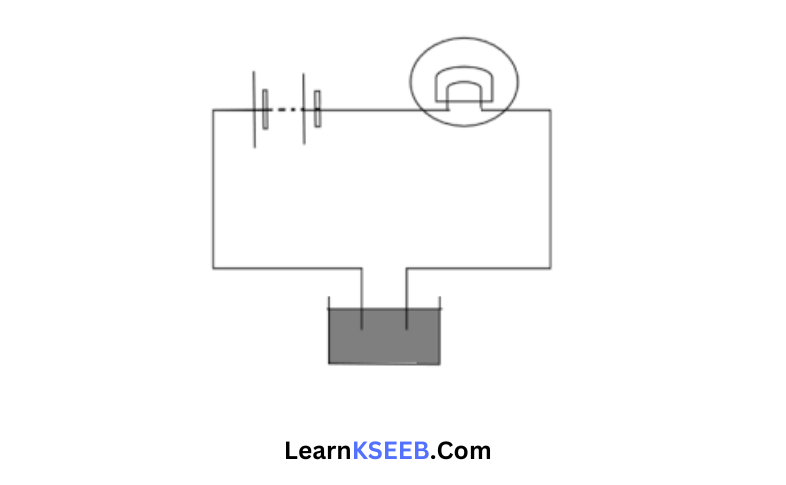
Answer: 4. Sugar solution in diluted water
Explanation: The sugar solution is neither acidic nor basic and it cannot ionize to conduct electricity. Similarly, distilled water has no ions in it to conduct electricity. Hence the mixture of sugar solution and distilled water will not conduct electricity.
Step-By-Step Solutions For Chemical Effects Of Electric Current Class 8 Karnataka Board
Question 8. Fill in the blanks
1. The object to be electroplated is taken as ______electrode.
2. One of the most common applications of the chemical effect of electric current is ________
3. Small amount of mineral salt present naturally in water makes it a ______ of electricity.
4. Electroplating of _________is done on objects like water taps and cycle bells to give them a shiny appearance.
Answer:
1. Cathode
2. Electroplating
3. Conductor
4. Chromium
Question 9. Why is a layer of zinc coated over iron?
Answer: Tron readily reacts with atmospheric air to form rust. In order to prevent it from rusting zinc is coated over iron.
Question 10. Will the solution of sugar in distilled water conduct electricity?
Answer: No, the sugar solution is neither acidic nor basic and it cannot ionize to conduct electricity.
Question 11. Name the effect of current responsible for the glow of the bulb in an electric circuit.
Answer: Heating effect of electric current.
Question 12. Boojho made the circuit given and observed that the bulb did not glow. On Paheli’s suggestion, he added one more cell in the circuit. The bulb now glows. Explain.
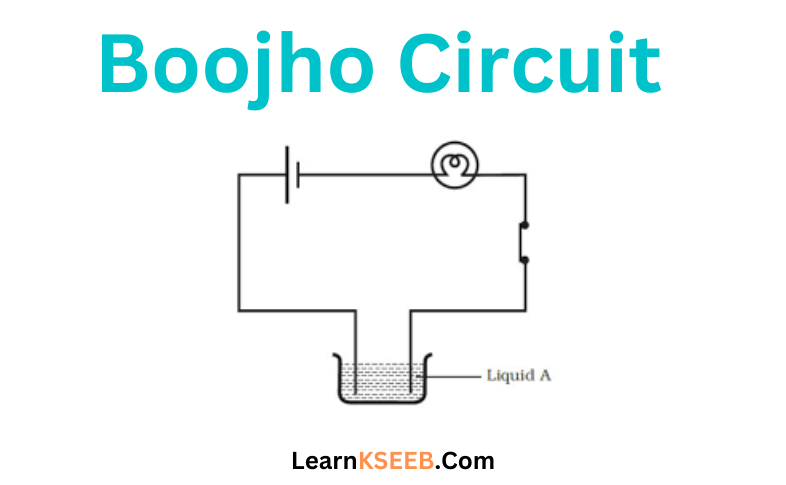
Answer: On adding another cell current flows through bulb sufficiently to make it glow.
Step-By-Step Solutions For Chemical Effects Of Electric Current Class 8 Karnataka Board
Question 13. Paheli set up an experiment using liquid A in the beaker She observed that the bulb glows. Then she replaced the liquid A by another liquid B. This time the bulb did not glow. Boojho suggested replacing the bulb by an LED. They observed that the LED glows. Explain.
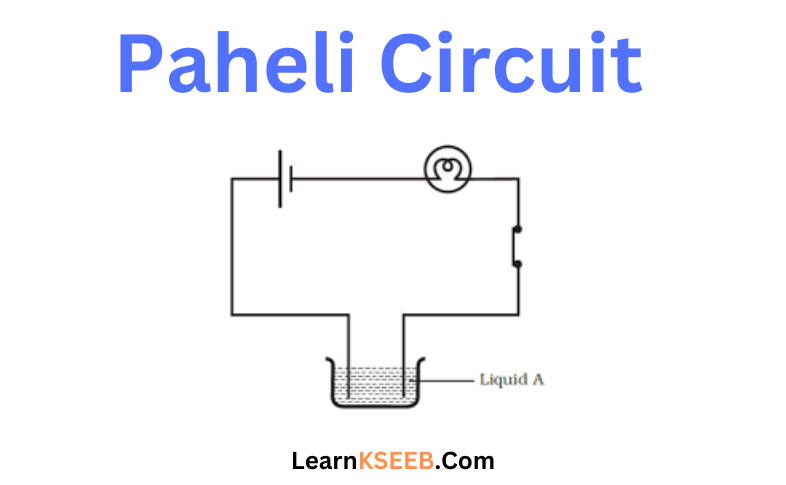
Answer: The current flowing through liquid B may be weak to make the bulb glow whereas it was strong enough to make the LED glow.
Simplified Notes For KSEEB Class 8 Science Electric Current
Question 14. Paheli wants to deposit silver on an iron spoon. She took a silver nitrate (AgNO3) solution in a beaker and set up a simple circuit for electroplating. Which terminal of the battery should the spoon be connected to? What material should the other electrode be made of?
Answer: The spoon should be connected to the negative terminal of the battery. The other electrode should be made of silver.
Question 15. Why is tin electroplated on iron to make cans used for storing food?
Answer: Tin is less reactive than iron. In order to prevent iron from reacting with food, tin is coated over iron for storing food.
Question 16. Which of these two circuits A or B shows the correct observation?
Answer:
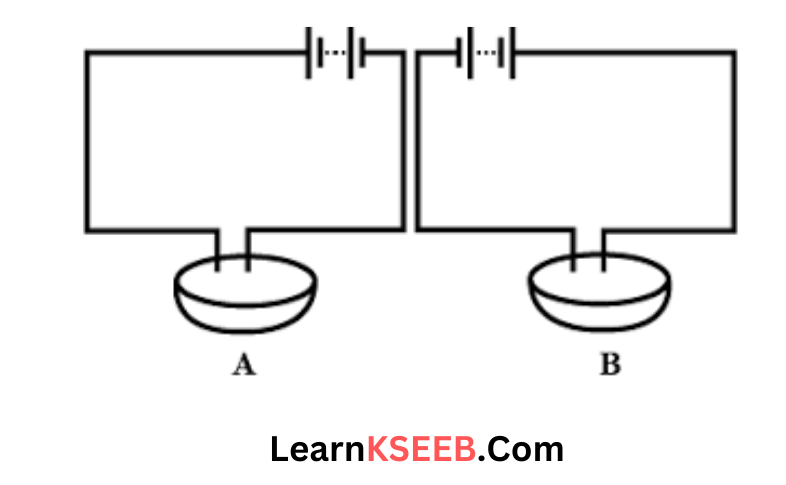
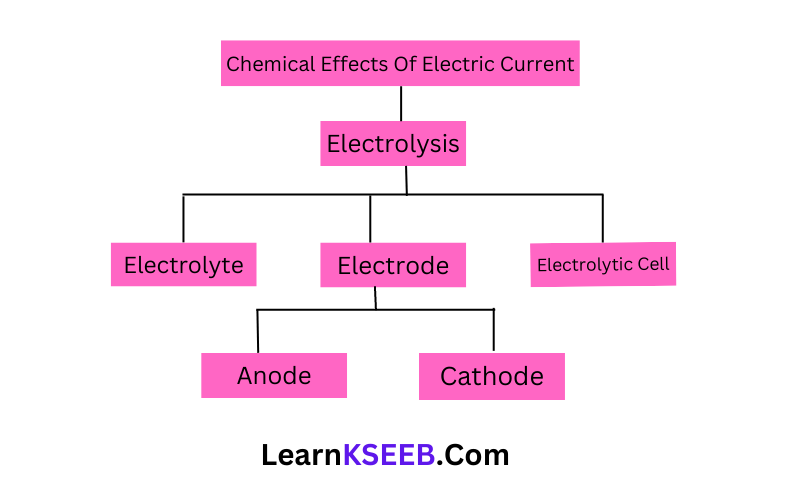
Karnataka State Board Syllabus for Class 8 Textbooks Solutions
- Chapter 1 Crop Production and Management
- Chapter 2 Microorganisms: Friend and Foe
- Chapter 3 Synthetic Fibres and Plastics
- Chapter 4 Materials: metals and Non-Metals
- Chapter 5 Coal and Petroleum
- Chapter 6 Conservation of Plants and Animals
- Chapter 7 Force and Pressure
- Chapter 8 Friction
- Chapter 9 Sound
- Chapter 10 Combustion and Flame
- Chapter 11 Cell Structure and Functions
- Chapter 12 Reproduction in Animals
- Chapter 13 Reaching the age of Adolescence
- Chapter 15 Some Natural Phenomena
- Chapter 16 Light
- Chapter 17 Stars and the Solar System
- Chapter 18 Pollution of Air and Water
